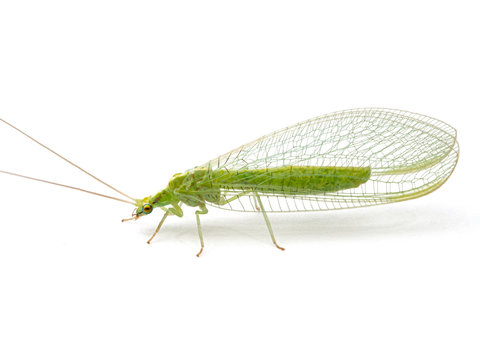The insect order Neuroptera, from Ancient Greek νεῦρον (neûron), meaning "nerve", and πτερόν (pterón), meaning "wing", also known as net-winged insects, includes the lacewings, mantidflies, antlions, and their relatives. The order consists of some 6,000 species. Neuroptera is grouped together with the Megaloptera (alderflies, fishflies, and dobsonflies) and Raphidioptera (snakeflies) in the unranked taxon Neuropterida (once known as Planipennia). Adult neuropterans have four membranous wings, all about the same size, with many veins. They have chewing mouthparts, and undergo complete metamorphosis. Neuropterans first appeared during the Permian period, and continued to diversify through the Mesozoic era. During this time, several unusually large forms evolved, especially in the extinct family Kalligrammatidae, often called "the butterflies of the Jurassic" for their large, patterned wings.


The larvae of most families are predators. Many chrysopids, hemerobiids and coniopterygids eat aphids and other pest insects, and some have been used for biological control (either from commercial distributors, but also abundant and widespread in nature). Larvae in various families cover themselves in debris (including other insects, living and dead) as camouflage, taken to an extreme in the ant lions, which bury themselves completely out of sight and ambush prey from "pits" in the soil. Larvae of some Ithonidae are root feeders, and larvae of Sisyridae are aquatic, and feed on freshwater sponges. A few mantispids are parasites of spider egg sacs. As in other holometabolic orders, the pupal stage is enclosed in some form of cocoon composed of silk and soil or other debris. The pupa eventually cuts its way out of the cocoon with its mandibles, and may even move about for a short while before undergoing the moult to the adult form. Adults of many groups are also predatory, but some do not feed, or consume only nectar. Beetles, wasps, and some lake flies parasitize neuropteran larvae.

The use of Neuroptera in biological control of insect pests has been investigated, showing that it is difficult to establish and maintain populations in fields of crops. Five species of Neuroptera are among 1681 insect species eaten by humans worldwide. The New Guinea Highland people claim to be able to maintain a muscular build and great stamina despite their low protein intake as a result of eating insects including Neuroptera.
